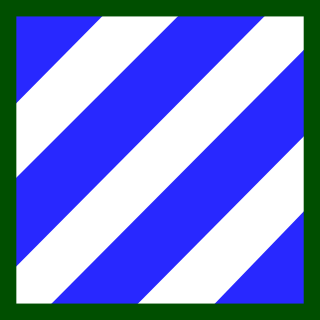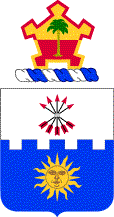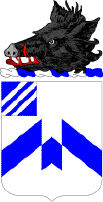
The 101st Airborne Division (Air Assault) ("Screaming Eagles") is a light infantry division of the United States Army that specializes in air assault operations. It can plan, coordinate, and execute multiple battalion-size air assault operations to seize terrain. These operations can be conducted by mobile teams covering large distances, fighting behind enemy lines, and working in austere environments with limited or degraded infrastructure. Its unique battlefield mobility and high level of training have kept it in the vanguard of U.S. land combat forces in recent conflicts: for example, foreign internal defense and counterterrorism operations in Iraq, in Afghanistan in 2015–2016, and in Syria, as part of Operation Inherent Resolve in 2018–2021.

The 3rd Infantry Division (3ID) is a combined arms division of the United States Army based at Fort Stewart, Georgia. It is a subordinate unit of the XVIII Airborne Corps under U.S. Army Forces Command. Its current organization includes a division headquarters and headquarters battalion, two armored brigade combat teams, one infantry brigade combat team, one aviation brigade, a division artillery, a sustainment brigade and a combat sustainment support battalion along with a maneuver enhancement brigade. The division has a distinguished history, having seen active service in World War I, World War II, the Korean War, and the Global War on Terror. The Medal of Honor has been awarded to 61 members of the 3rd Infantry Division, making the division the most honored in the Army.

The 1st Infantry Division is a combined arms division of the United States Army, and is the oldest continuously serving division in the Regular Army. It has seen continuous service since its organization in 1917 during World War I. It was officially nicknamed "The Big Red One" after its shoulder patch and is also nicknamed "The Fighting First." The division has also received troop monikers of "The Big Dead One" and "The Bloody First" as puns on the respective officially sanctioned nicknames. It is currently based at Fort Riley, Kansas.

The 4th Infantry Division is a division of the United States Army based at Fort Carson, Colorado. It is composed of a division headquarters battalion, three brigade combat teams, a combat aviation brigade, a division sustainment brigade, and a division artillery.

The 39th Infantry Brigade Combat Team, also officially known as The Arkansas Brigade, is an infantry brigade combat team of the Army National Guard composed of personnel from the U.S. states of Arkansas, Missouri, and Nebraska. The unit is the largest Army National Guard command in Arkansas and is headquartered at the Camp Robinson Maneuver Training Center. It was ordered into federal service in 2003 in support of Operation Iraqi Freedom II. The 39th was attached to the 1st Cavalry Division and served in and around Baghdad for a year, returning to the United States in March 2005.

The 10th Mountain Division (Light Infantry) is a light infantry division in the United States Army based at Fort Drum, New York. Formerly designated as a mountain warfare unit, the division was the only one of its size in the US military to receive specialized training for fighting in mountainous conditions. More recently, the 10th Mountain has been conducting operations in Iraq and Syria advising and assisting Iraqi Security Forces and People's Defense Units.

The 25th Infantry Division is a United States Army division based at Schofield Barracks in Hawaii. The division, which was activated on 1 October 1941 in Hawaii, conducts military operations primarily in the Asia-Pacific region. Its present deployment is composed of light infantry and aviation units. Tropic Lightning soldiers regularly train with other U.S. military branches to practice and maintain joint operations capabilities. The climate and terrain of the Pacific region demands Tropic Lightning soldiers be able to operate in physically demanding and harsh environments. In 2014, the division opened the Jungle Operations Training Center—the first such school in the Army since the closing of the old Jungle Warfare School at Fort Sherman, Panama Canal Zone. Joint operations and training with partner states herald a new chapter in the history of Tropic Lightning—America's Pacific Division.

The 506th Infantry Regiment, originally designated the 506th Parachute Infantry Regiment during World War II, is an airborne light infantry regiment of the United States Army. Currently a parent regiment under the U.S. Army Regimental System, the regiment has two active battalions: the 1st Battalion, 506th Infantry Regiment is assigned to the 1st Brigade Combat Team, 101st Airborne Division, and the 2nd Battalion, 506th Infantry Regiment is assigned to the 3rd Brigade Combat Team, 101st Airborne Division.

The 187th Airborne Infantry Regiment (Rakkasans) is a regiment of the 101st Airborne Division.
The 2nd Brigade Combat Team, 1st Infantry Division, also known as the Dagger Brigade, is a maneuver brigade combat team in the 1st Infantry Division of the U.S. Army stationed in Fort Riley, Kansas.

The 22nd Infantry Regiment is a parent regiment of the United States Army. Currently the 2nd Battalion is active, with the regimental colors residing at Fort Drum, New York. The 1st, 3rd, and 4th Battalions have been inactivated.

The 325th Airborne Infantry Regiment is a light infantry parachute insertion fighting force of the United States Army. The subordinate units of the regiment constitute the bulk of the infantry elements assigned to the 2nd Infantry Brigade Combat Team, 82nd Airborne Division.

Below is an estimated list of the major units deployed within the Multi-National Force – Iraq and other United States military units that were operating in Iraq under the U.S. Central Command (USCENTCOM) in 2009, during the Iraq War.

The 16th Infantry Regiment is a regiment in the United States Army and has traditionally been a part of the 1st Infantry Division.

The 30th Infantry Regiment is a United States Army infantry regiment. It was originally constituted 2 February 1901 in the Regular Army as the 30th Infantry. It was organized 12 February – 19 August 1901 at Fort Logan, Colorado, at the Presidio of San Francisco, California, and in the Philippines.

David Louis Finkel is an American journalist. He won a Pulitzer Prize in 2006 as a staff writer at The Washington Post. As of January 2017, he was national enterprise editor at the Post. He has also worked for the Post's foreign staff division. He wrote The Good Soldiers and Thank You for Your Service. He is a 2012 MacArthur Fellow.
The 64th Armor Regiment is an armor regiment of the United States Army, organized under the United States Army Regimental System. It is descended from the 758th Tank Battalion (Light) that served in the Italian campaign during World War II. Redesignated as the 64th Tank Battalion, it was assigned to the 3rd Infantry Division during the Korean War and it spent most of the Cold War stationed in West Germany before elements were transferred to Ft. Stewart, Georgia in the late 1990s. The regiment participated in Desert Shield, Desert Storm, Desert Fox, Desert Spring, Operation Iraqi Freedom and Operation Enduring Freedom.

The 1st Battalion, 153d Infantry Regiment , is an infantry battalion of the Arkansas Army National Guard, headquartered at Malvern, assigned to the 39th Infantry Brigade Combat Team. The 1–153rd has deployed companies in support of the Multi-National Security Force to Bosnia and to Saudi Arabia as part of Operation Southern Watch. 1st Battalion, 153rd Infantry has twice deployed as a battalion for Operation Iraqi Freedom, once from 2004–05 and a second time in 2008. The battalion was awarded the Meritorious Unit Citation for the period, 17 March 2004 – 23 March 2005.

3rd Battalion, 153rd Infantry Regiment was a United States infantry battalion, headquartered at Warren, Arkansas, assigned to the 39th Infantry Brigade Combat Team of the Arkansas Army National Guard until it was deactivated on 5 September 2005. The history of the 3rd Battalion, 153rd Infantry as an individual battalion begins with the reorganization of the 39th Infantry Division in 1967 and the creation of the 39th Infantry Brigade (Separate). For history of the 3rd Battalion prior to 1967, see 153rd Infantry Regiment and 39th Infantry Division.

The 32nd Field Artillery Regiment is a distinguished and highly decorated field artillery regiment of the United States Army, first Constituted in 1918.
















